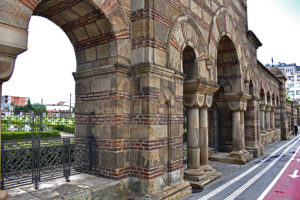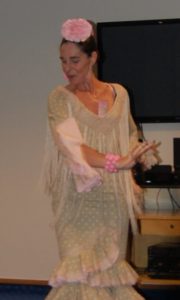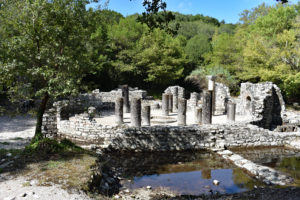Look left, look right and the beach stretched for a kilometre with cliffs at either end. In the middle breakers were tempting surfers but few swimmers. Perfect for paddling though, and many took to it.
Hotel Juan de la Cosa is four star, and the accommodation lives up to it. Cantabrian food offers an interesting take on tapas but has the splendid tortilla or Spanish omelette in two or three guises. Main courses are wide-ranging, with seafood and fish prominent but not overwhelming. The local wines are good.
A helpful map showed how we could reach the local town, Santona, 2 kilometres away. There are frequent buses, both there and to Laredo in one direction or Santander in the other. Our interest was most aroused, though, by the salt marsh just inland from the hotel. For the nervous it could be reached by a short bus ride towards Santona or a walk of about one kilometre on pavement. We tried the walk, crossing by the gates of what they say is the happiest prison in Spain (another story!) and taking a broad footpath that seemed more of a cart track.
Around a dozen grey heron took off from one of the lagoons about 100 metres from the path. We’d never seen so many before, and unfortunately didn’t again despite or because I had the camera ready. At the end of the path was a bird hide, but we were clearly between seasons. Many migrant birds have been sighted as well as residents but we saw only gulls and a few little egrets. One egret was with cattle – not a cattle egret, it transpired.
The good point was the path took a route back towards the hotel. As others had taken it we thought we should too. One tricky negotiation where the bank had collapsed was all we had to contend with. There were more little egrets and heron plus, just as we reached the end, a ringed plover. A few days later there were two ringed plovers at a distance but within camera range.
Now for the nervous: the path ends at a dual carriageway, clearly the route to and from work for locals. Protected by the safety barrier we were able to walk to a bridge. It had a broad pavement with semi-circular refuges and an opening to cross the road. The sightlines were good so we could pick our time to cross without haste. Once across the path took us through a small housing development and back to the hotel. It was worthwhile taking the route twice more during the week, to be quickly among the marshes.
Obviously most people go for the beach and we were glad to join them. A leisurely or energetic traverse in both directions certainly works up an appetite. The cliffs at each end offer paths upward, the eastern one a road used only by cyclists and authorised vehicles, the western one for walking (with a little scrambling). We had been along the first in a group past Napoleonic War batteries to see the lighthouse. It also offers a good view down on the prison. Most inmates (including British) are there for drug offences. They have a worthwhile work regime, plenty of exercise, with running track, games, and other activities, so all that might induce them to escape is the sound of the sea.
The western footpath was a solo outing. It is clearly visible from anywhere along the beach and can be joined at two or three points. The higher I climbed the more I came to agree with Macbeth – not murder but the wish not to retrace steps: “Returning were as tedious as go o’er.” At the top I hoped for a path onward and, fortunately, found it. Even a couple of kilometres extra would have been preferable to what, at a certain age, appears vertigionous. As well as the views back there was a panorama onward to another bay, a distant town but not – all in good taste – the local nudist beach.
The onward path continued to climb a little, and seemed more of a goat track than a regular footpath. It did turn down, however, and in fact became a woodcutters’ or – who knows? – smugglers’ route, fairly broad in places but not much used recently. The way down was through woodland, so the shade was welcome after a clear sky with temperatures in the high 20s. Just one problem was the snort and scuffle of hooves that I’m convinced was a wild boar making its way off among the trees. A few minutes later and not only was I down but also where the upward path I’d taken began. The way back to the hotel was along pavement and no more than 200 metres.
Our one visit to Santona had been spoiled by the only rain of the holiday, but by noon the day was merely cloudy. Just as well for the locals as it was the day of their annual feast and bullfight. The entire hotel staff was in a state of excitement because the matadors and their entourage had spent the night there. At lunchtime there were selfies and autograph collecting as well as a huge meal for everyone. Excitement mounted through the afternoon. At five o’clock there was an appearance, in full regalia, of all who would enter the ring: first picadors and after toreadors, who ride horses then, after a delay that had us worrying they would never reach the ring in time, the three matadors. Not quite the three tenors, though two seemed to have experienced many an occasion together, and the third – to the delight of the young afficionados – like the David Beckham of the bullring. Discussion among the British followed, as to how Ronaldo would enjoy the dressing up but not the facing up. In a few moments they were gone and we went inside for our afternoon tea.
Not that we were disappointed at missing the bullfight, there was a performance by a Spanish dancer that evening. She is so good that companies in Madrid have asked her to join but she prefers to teach locally and remain with her family. It was a fine way to spend an evening in the hotel and one more addition to a splendid week.










